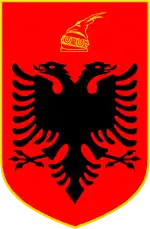Istrian Albanian
Istrian Albanian was a Gheg variety of the Albanian language, spoken in the village of Katun in the area of Poreč, Istria.[2]
| Istrian Albanian dialect | |
|---|---|
| Region | Istria |
| Extinct | 17th century |
Indo-European
| |
Early forms | |
| Language codes | |
| ISO 639-3 | – |
| Glottolog | istr1247 |
| Part of a series on |
| Albanians |
|---|
 |
| By country |
|
| Culture |
| Religion |
| Languages and dialects |
History
From the 13th to the 17th century the depopulation of the Istrian Peninsula prompted the Republic of Venice to repopulate the region with settlers, which among others included Albanians.[3] The coalescence of the various dialects spoken by the settlers led to the formation of the Istrian Albanian dialect. The only surviving text of the dialect was written by the local scholar Pietro Stancovich in the 1830s. Stankovich recorded a version of the Parable of the Prodigal Son and a vocabulary list of the dialect.[4]
References
- "Glottolog 4.6 - Istra Albanian".
- "Albanian language - Dialects". Britannica.com Inc. Retrieved 2 March 2012.
- Fine, John Van Antwerp (2006-03-02). When ethnicity did not matter in the Balkans: a study of identity in pre-nationalist Croatia, Dalmatia, and Slavonia in the medieval and early-modern periods. University of Michigan Press. p. 118. ISBN 978-0-472-11414-6. Retrieved 2 March 2012.
- Altimari, Francesco (2011). "Analisi di alcuni manoscritti con testi e lessemi sull' albanese dell' Istria" (PDF). Ludwig Maximilian University of Munich. Archived from the original (PDF) on 13 February 2012. Retrieved 2 March 2012.
This article is issued from Wikipedia. The text is licensed under Creative Commons - Attribution - Sharealike. Additional terms may apply for the media files.